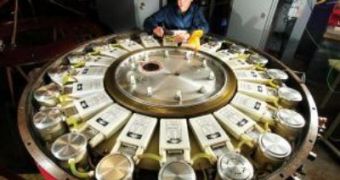One step closer to a high-yield fusion reactor: a new, revolutionary electrical circuit should carry enough power to produce the long-sought goal of controlled high-yield nuclear fusion. But wait, there's more: it can do it every 10 seconds.
Sandia National Laboratories' Z machine is already the largest producer of X-rays on Earth and has been used to produce fusion neutrons. But rapid bursts are necessary for future generating plants to produce electrical power from sea water. This had not been thought achievable till now.
Nuclear fusion is the process by which multiple nuclei join together to form a heavier nucleus. It is accompanied by the release or absorption of energy. In astrophysics, fusion reactions power the stars and produce all but the lightest elements.
On Earth, when the reaction is a sustained uncontrolled chain, it results in a thermonuclear explosion like in a hydrogen bomb. Harnessing that energy and converting it into electricity is a dream come true.
You can just imagine that an automobile engine that fires one cylinder and then waits for hours before firing again wouldn't take a car very far.
Providing electrical energy from cheap, abundant seawater for all humanity can't be done with a device that fires once and quits for the day. It must deliver energy to fuse pellets of hydrogen every 10 seconds and keep that pace up for millions of shots between maintenance, a kind of an internal combustion engine for nuclear fusion. That's so, at least, for the fusion method at Sandia National Laboratories' Z machine and elsewhere known as inertial confinement.
But, unable to produce fusion except episodically, the method has been overshadowed by the technique called magnetic confinement - a method that uses a magnetic field to enclose a continuous fusion reaction from which to draw power.
The electrical circuit emerging from the technological hills may change the balance between these systems. Tagged as "revolutionary" by ordinarily conservative researchers, it may close the gap between the two methods.
The circuit is easily able to fire every 10.2 seconds in brief, powerful bursts. "This is the most significant advance in primary power generation in many decades," says Keith Matzen, director of Sandia's Pulsed Power Center.
The new system, called a linear transformer driver (LTD), was created by researchers at the Institute of High Current Electronics in Tomsk, Russia, in collaboration with colleagues at Sandia.
This new technology represents a remarkable technical advance that will hopefully lead to more efficient nuclear fusion applications.

 14 DAY TRIAL //
14 DAY TRIAL //